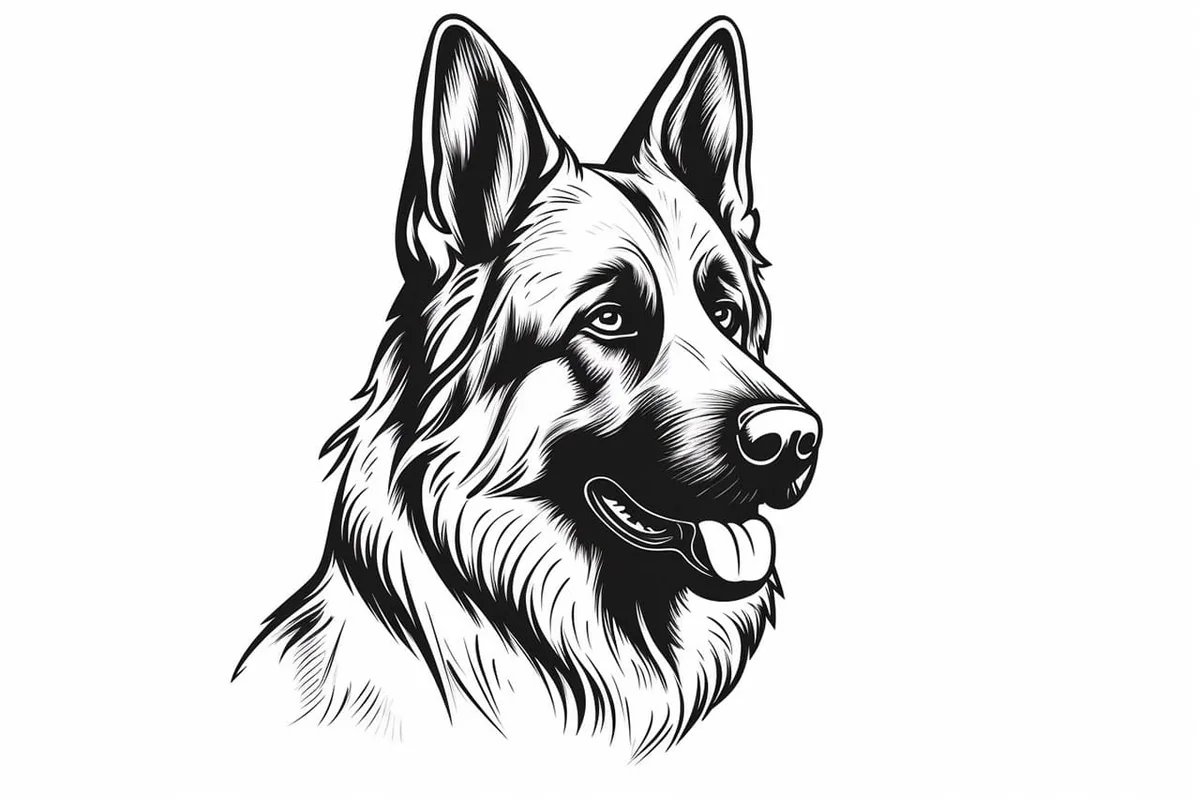How to Draw a German Shepherd in 7 Simple Steps
Learn how to draw with this step-by-step tutorial.

Materials You'll Need
- Drawing paper
- Pencil (HB or 2B)
- Eraser
- Blending stump

Welcome to this comprehensive tutorial where we'll guide you through the process of how to draw a German Shepherd! Known for their striking appearance, loyal nature, and intelligent demeanor, German Shepherds are one of the most beloved and recognizable dog breeds. Drawing this majestic breed is both a rewarding challenge and an opportunity to develop your artistic skills.
In this step-by-step guide, we'll break down the process into easy-to-follow stages, helping you capture the unique features of a German Shepherd, from its alert ears and expressive eyes to its strong, athletic body and distinctive coat markings. Whether you're a beginner eager to explore pet portraits or an experienced artist refining your craft, this tutorial is designed to make drawing a German Shepherd both achievable and enjoyable.
So, grab your pencils, find a quiet spot to focus, and let's bring this noble canine to life on paper!



Materials Required
Before we begin, make sure you have the following materials at hand:
-
Drawing paper: Choose a smooth and heavyweight paper suitable for your chosen medium.
-
Pencils: A range of pencils with different hardness, such as 2H, HB, and 2B.
-
Eraser: A kneaded eraser is recommended for easy corrections and blending.
-
Blending tools: You can use a blending stump or a tortillon for smooth shading.
-
Reference photo: Find a clear and high-resolution image of a German Shepherd to use as a visual reference.
Now that you have your materials ready, let's dive into the step-by-step process of drawing a German Shepherd.
How to Draw a German Shepherd: Step-by-Step Guide
German Shepherds are known for their intelligence, strength, and striking appearance, making them a rewarding subject for artists. With their alert expression, pointed ears, and flowing fur, capturing the essence of a German Shepherd requires careful attention to shape, texture, and proportion. In this tutorial, you'll learn how to build your drawing step-by-step, from basic shapes to detailed fur shading.
Step 1: Sketch Basic Shapes and Proportions
Start with a light pencil sketch to map out the fundamental structure.
-
Draw an oval for the head, tilted slightly to suggest a natural, alert posture.
-
Add a larger circle or rounded rectangle for the body, positioned lower and slightly back from the head.
-
Connect the head and body with a gently curved line to form the neck, showing the natural flow between the two.
Keep your lines loose and light—you'll refine everything as you go.
Step 2: Outline the Head and Muzzle
Refine the head shape using the oval as a guide.
-
Define the broad forehead and strong jawline characteristic of the breed.
-
Extend a slightly curved line forward to form the muzzle, which narrows toward the nose.
-
Add structure to the cheeks and sides of the face, keeping the outlines soft and natural.
Observe reference photos to get a sense of the German Shepherd's strong, confident profile.
Step 3: Draw the Eyes, Nose, and Mouth
Now bring expression to your German Shepherd's face.
-
Draw two almond-shaped eyes positioned above the muzzle, slightly angled for alertness.
-
Inside each eye, sketch a small circle for the iris and a tiny dot for the pupil, leaving a highlight spot to show life and shine.
-
Add a small triangle for the nose, placed just above the end of the muzzle. Shade it dark, leaving a tiny highlight for a moist, realistic effect.
-
Sketch a curved line for the mouth, starting from below the nose and sweeping back into a relaxed, closed or slightly open shape.
The subtle tilt and size of the eyes and mouth will greatly affect the expression—gentle adjustments can create very different moods!
Step 4: Shape the Ears and Add Facial Features
Draw the German Shepherd's signature pointed ears.
-
Sketch two upright triangles on top of the head, spaced evenly but angled slightly outward.
-
Add a few soft curves inside the ears to suggest depth and structure.
-
Lightly sketch fur lines around the cheeks, chin, and forehead, following the natural flow of the coat.
Not all German Shepherd ears stand perfectly straight—feel free to show one ear tilting slightly for character!
Step 5: Build the Body and Add the Legs
Refine the body using your earlier circle as a guide.
-
Draw a broad chest tapering back into a narrower waist, typical of the athletic German Shepherd build.
-
Add the front legs using slightly angled vertical lines, ending in ovals for the paws.
-
Draw the hind legs with a slight bend at the "knee," angled to show the powerful haunches.
-
Position the legs firmly under the body to support a confident, balanced stance.
Use long, smooth lines for muscles and joints—think about how the dog's weight is distributed.
Step 6: Add Fur Texture and Begin Shading
Start layering in the rich coat texture.
-
Use short, overlapping pencil strokes along the body, face, and legs to mimic the fur's direction.
-
Focus on fur flow—shorter strokes around the face and legs, and longer strokes along the body and tail.
-
Shade with varied pencil pressure:darker areas under the chin, along the back, and behind the legs, and lighter areas across the chest and face.
Always shade in the direction the fur grows—it helps build natural realism.
Step 7: Draw the Tail and Finalize the Details
Complete your drawing by adding the tail.
-
Sketch the tail with smooth, flowing lines, slightly curved downward or to the side.
-
Fill it with long, textured strokes to create the feathery look typical of German Shepherds.
-
Deepen shadows in the fur, refine facial details, and clean up any rough sketch marks.
-
Erase any remaining construction lines for a clean, polished finish.
A lively tail and detailed paws add an extra touch of character to your finished drawing.
Final Touch: Capturing the Spirit of a German Shepherd
Congratulations—you've created a detailed drawing of one of the most iconic dog breeds! By carefully building the structure, adding expressive features, and layering realistic fur textures, you've captured the intelligence and strength that make German Shepherds so beloved.
Remember, every drawing improves with practice. Try sketching your German Shepherd in different poses, expressions, or even playful action scenes to keep challenging your skills and expanding your artistic range. Stay observant, patient, and most importantly, have fun bringing these noble companions to life on paper! Happy drawing!
Fun Facts About German Shepherds
-
German Shepherds were first bred in Germany in the late 1800s, originally developed to be the perfect herding and working dog.
-
The breed's founder, Max von Stephanitz, wanted a dog that was smart, loyal, strong, and versatile—qualities German Shepherds still embody today.
-
German Shepherds are one of the most intelligent dog breeds, capable of learning dozens of commands and complex tasks.
-
These dogs are natural protectors, often working as police dogs, search and rescue dogs, service animals, and military K9s.
-
Despite their tough reputation, German Shepherds are incredibly loyal and loving with their families, often forming deep bonds with their humans.
-
German Shepherds are known for their iconic appearance: upright ears, a long bushy tail, a confident stance, and a beautiful coat that can be black and tan, sable, or even solid black or white.
-
Their sense of smell is so powerful that they can detect explosives, narcotics, and even certain diseases!
-
German Shepherds are featured in popular culture—from Rin Tin Tin, the famous movie dog, to countless appearances in TV shows, books, and even animated films.
-
A well-trained German Shepherd can respond to commands with lightning speed, making them not only reliable workers but also incredible canine athletes.
-
German Shepherds require mental stimulation and regular exercise, thriving when they have a job to do or activities that challenge both their bodies and minds.
Tip: To effectively capture the unique features of a German Shepherd, start by using a high-quality reference photo that highlights their distinct anatomy, especially the structure of their head, ears, and fur patterns. Focus on light and shadow; utilizing a blending stump or your fingers can help create a smooth transition between tones, which is essential for depicting the dog's muscular build and shiny coat. When sketching, use light, loose lines to outline the basic shapes, allowing for adjustments as you refine details. Pay special attention to the eyes, as they convey emotion and character—consider them the focal point of your drawing. Lastly, experiment with different pencil grades; softer pencils (like 2B or 4B) are excellent for deep shadows, while harder pencils (like H or 2H) work well for fine details and sharper lines.
Suggested Scenes and Settings for German Shepherd Drawings
-
Loyal Companion at the Park: Draw a German Shepherd sitting proudly beside their human at a sunny park, with trees, a ball, and wagging tails in the background.
-
Police Dog in Action: Illustrate a K9 unit German Shepherd, complete with a vest, running alongside an officer or sniffing out clues in an urban setting.
-
Mountain Hike Adventure: Picture a German Shepherd trekking up a rocky trail with a backpack, tongue lolling and ears perked, under a bright blue sky.
-
Puppy Playtime: Create an adorable scene of a fluffy German Shepherd puppy chasing butterflies, pouncing on toys, or flopping into a pile of leaves.
-
Guarding the Homestead: Show a German Shepherd standing watch at a farmhouse fence at sunset, with fields and barns stretching into the distance.
-
Training Session: Draw a focused German Shepherd practicing obedience drills—sitting, staying, and jumping through hoops—with treats and toys nearby.
-
Snowy Patrol: Illustrate a German Shepherd bounding through deep snow, leaving a trail of paw prints, their breath misting in the chilly air.
-
Heroic Rescue: Depict a German Shepherd guiding a lost child through the woods or assisting in a mountain rescue mission.
-
Chill Time at Home: Create a cozy scene with a German Shepherd snoozing by the fireplace, curled up on a favorite rug with a sleepy smile.
-
Fantasy Armor Shepherd: For a whimsical twist, draw a German Shepherd wearing medieval armor or a magical cloak, standing guard over a fantastical realm.